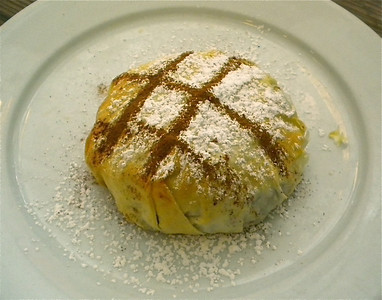Lunch this week at the Moroccan restaurant Cafe Mogador reminded me of just how much I love this lively North African cuisine. Heady spices merge with fluffy grains, piquant fruits, and tender pulses, poultry and fish to create some of the most distinctive, delectable foods that I’ve ever eaten. Of the wonderful Moroccan offerings, the most unique has to be bisteeya. Considered by many to be Morocco’s most complex and elegant dish, this flaky, poultry-filled pastry remains beyond compare.

Bisteeya has its roots in the Middle East. As early as the 7th century, Arab invaders introduced the concept of encasing spiced meats and nuts in dough. They also encouraged the use of paper-thin leaves of pastry, which Moroccans perfected and now refer to as warka. Warka is one of several ingredients that make bisteeya so memorable.
To make warka, you press a ball of well-kneaded dough onto a hot, flat pan. As soon as the edges begin to dry, peel off the leaf and place it on a clean, flat surface. Cover it with a towel so that it doesn’t dry out. Repeat this process until you have enough warka for a bisteeya. It seems to takes mere seconds to create a delicate warka leaf. Yet, in reality three hours could pass before you have the needed 40 or so leaves.
Not only the fragile casing but also the sweet and savory filling contribute to bisteeya’s uniqueness. Traditionally, the stuffing features poached and shredded squab (young pigeon) or chicken. Placed on sheets of warka, the poultry is covered with a mixture of eggs and a lemon-onion sauce before being blanketed with dough. A layer of sugar-dusted almonds follows before the final sheets of warka are tucked around and under the tartly sweet stuffing. Once it’s finished baking, the top of the pastry is decorated with cinnamon and confectioner’s sugar.
Cut into the golden pastry and you’ll encounter a warm, aromatic blend of saffron, tumeric, lemon, garlic and cinnamon. Take a bite and you’ll experience the perfect combination of moist and crisp, savory and sweet. It’s otherworldly.
Since I usually lack the time — and patience — to fuss with homemade warka, my bisteeya isn’t as authentic or ethereal as it could be. However, in a pinch, store-bought phyllo dough serves as a good substitute. Should you decide to make your own dough, consult Paula Wolfert’s Couscous and Other Good Food from Morocco (William Morrow, 1987). She devotes an entire chapter to this topic.
BISTEEYA
Adapted from Sarah Woodward’sTastes of North Africa (Kyle Cathie LImited, 1998)
Serves 6 to 8
1 pound chicken breasts
4 sprigs each fresh parsley and cilantro, tied together
1 stick cinnamon
1/2 teaspoon black pepper
1/4 teaspoon saffron
pinch of sea salt
1 white onion, peeled and grated
8 to 10 tablespoons unsalted butter
7 ounces whole blanched almonds
1 teaspoon ground cinnamon
1 1/2 tablespoons confectioner’s sugar
4 whole eggs
4 egg yolks
2 tablespoons lemon juice
1 pound phyllo dough
ground cinnamon, for garnish
confectioner’s sugar, for garnish
Place the chicken in a casserole or heavy pan. Add the herbs, cinnamon, black pepper, saffron, salt, onion and four tablespoons of butter. Pour in enough water to just cover the chicken. Bring the water to a boil, lower to a simmer, cover and allow to cook for 1 to 1 1/4 hours.
As the chicken cooks, heat 1 tablespoon of butter in a small frying pan. Add the almonds and toast until golden. Remove from heat and allow to cool. Once they’ve cooled, grind the almonds in a food processor or blender. Add the 1 teaspoon of cinnamon and 1 1/2 tablespoons of confectioner’s sugar to the ground almonds and mix to combine.
Remove the chicken from the poaching liquid and allow to cool before cutting or shredding into small pieces. Boil down the remaining liquid to half its volume and then set aside to cool.
Beat together the eggs and egg yolks until frothy. Add the lemon juice and beat again. Stir the egg mixture into the reduced liquid. Return the pan to the heat and simmer on low, stirring constantly until the sauce thickens. Check and adjust the seasonings as needed.
Preheat the oven to 350 degrees Fahrenheit. Lightly grease a shallow, non-stick pie pan. Melt the remaining butter over low heat and skim off any scum on top.
Lay a sheet of phyllo across the greased pie pan, allowing the edges to hang over, and brush lightly with the melted butter. Lay another sheet at an angle and brush it with butter, too. Repeat with another 4 sheets of phyllo so that the pie dish is completely covered and a circle has been formed.
Scatter the shredded chicken over the pastry. Top with the egg sauce. Fold 2 layers of phyllo in half and place in the preheated oven for 1 minute to crisp up. Place over the egg sauce and top with the almond-cinnamon-sugar mixture. Fold in the overlapping edges of phyllo, brushing the surface lightly with butter. Lay two sheets of phyllo over the surface and gently tuck them under the pie, cutting off any excess dough. Brush the surface with the melted butter.
Bake for 30 minutes and then carefully invert the pie onto a baking sheet. Bake it upside down for another 20 minutes before returning it to the top side. Bake for 10 more minutes, until the top is crisp and golden. Sprinkle with cinnamon and sugar and serve hot.